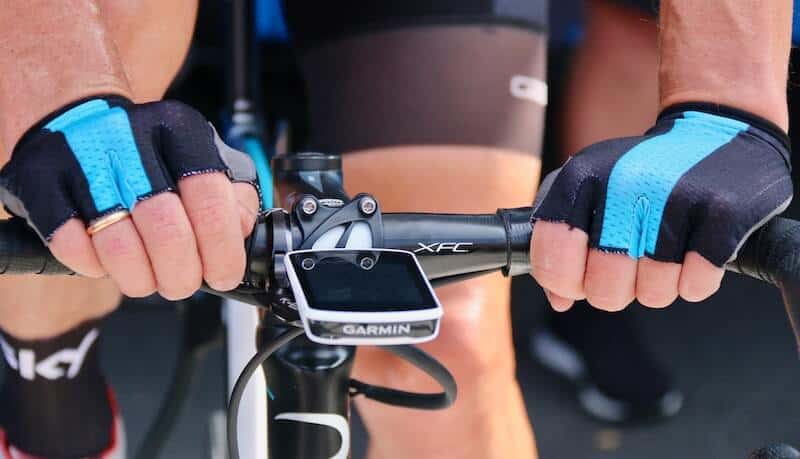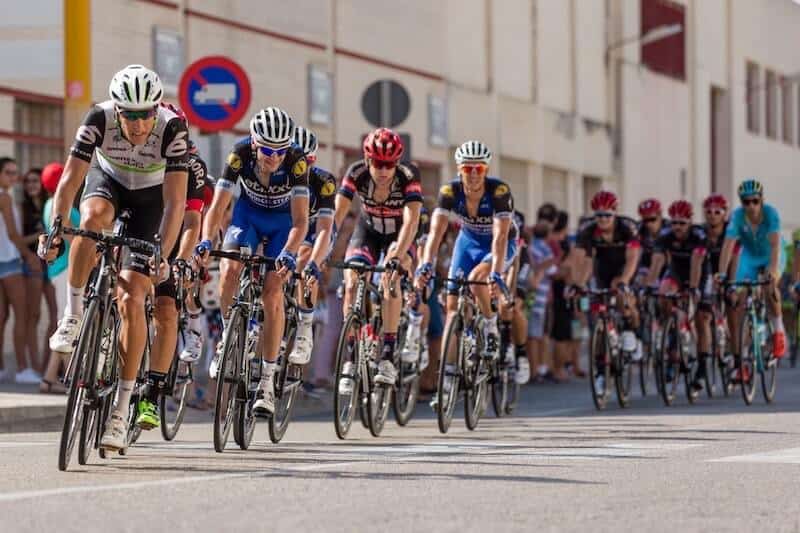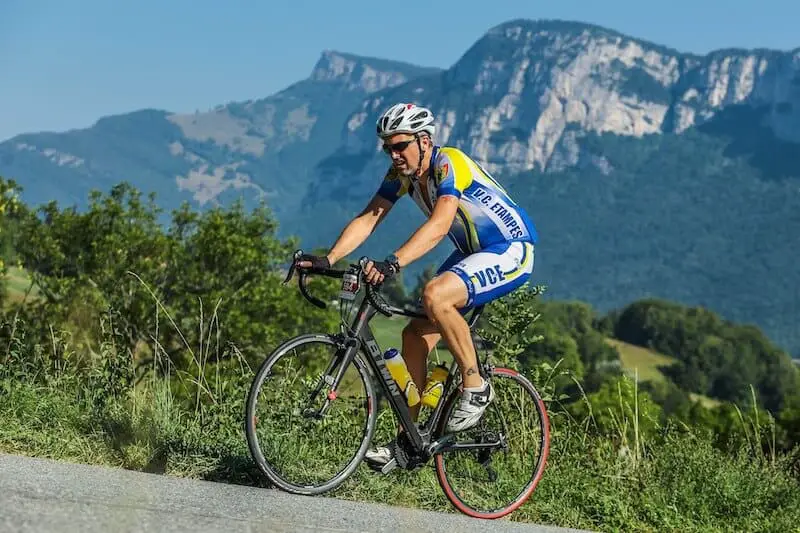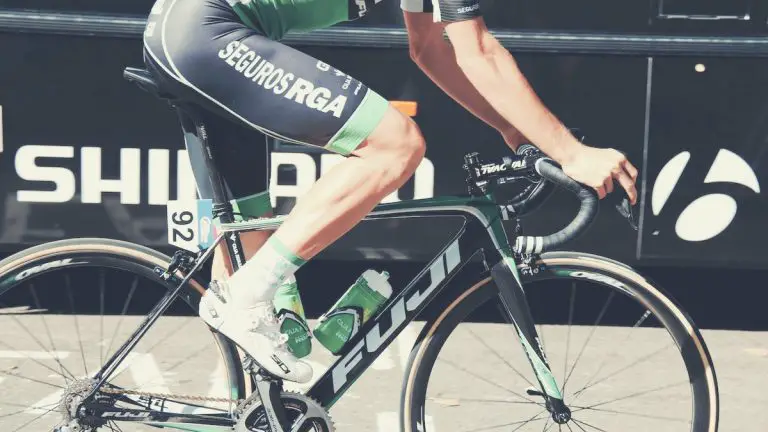Although cadence is often associated with music or a lyrical voice, it takes on a completely different meaning in cycling. So, what is cadence in cycling?
- Cycling cadence is the number of rotations one pedal makes per minute.
But how does this translate into cycling? In this post, I’ll delve into:
- How to measure cadence
- Efficient cadence
- How to increase your cadence
- Cadence and climbing
How To Measure Cycling Cadence
Here are two accessories you can purchase to measure cadence.
- Power meter – Aside from calculating your power (watts), it will also determine cadence and speed (e.g. Garmin Vector Power Meter). However, these aren’t cheap.
- Cadence sensor – These add-ons are more affordable (e.g. Wahoo RPM Cadence sensor) and use Bluetooth to send cadence information to your bike computer.
There is also an old-school method using basic mathematics and a stopwatch. I recommend doing this on an indoor trainer for safety reasons. Here are the formulas:
- Count the number of rotations one pedal makes in 1 minute.
- Count the number of rotations one pedal makes in :30 and multiply by 2.
- Count the number of rotations one pedal makes in :06 seconds and multiply by 10.
I use #3 on the road because it’s short enough to do without me being too distracted. Although this is the least accurate formula, it will get you in the ballpark of your cadence.

What’s A Good Cadence for Cyclists?
Before answering that, let me address why a higher cadence is better.
- Efficiency – Studies have shown that a cadence in the 80 RPM range is more efficient. I’ll go into this in more detail in a bit.
- Avoid injury – If you have knee problems, pounding big gears in a low cadence, say 60 RPM, can irritate these. Even if you’re young, spry, and injury-free, this approach to pedaling could lead to complications later on in life.
- Better bike handling skills – Spinning at a higher cadence, with proper technique, creates a smooth pedaling motion that translates into less wobble and better command of your bike. If you don’t believe me, watch the pros ride; seamless perfection in shoulder-to-shoulder pelotons; smooth as silk pedaling at 90-100 RPM with statuesque, yet relaxed, upper bodies.
Now back to the question. As you’ve probably guessed, the average cyclist has a cadence of around 60-70 rpm. Elite cyclists range in the 80-90 range while pro cyclists are in the 90-100.
As I’ve already hinted at, the ideal cadence is in the 80 range, but why is this? Higher cadences utilize your slow-twitch muscles and increase oxygen and blood flow, which are necessary for endurance. Lower cadences use your fast-twitch muscles designed for power. Although needed for sprinting, it would put too much strain on your muscles and cardiovascular system in endurance events. Lastly, cardiovascular systems recover faster than muscles.
For some, a faster cadence is an insult to their skills or even their manhood. The notion goes like this: “I’ve got tree trunks for legs! I can handle mashing big gears. Spinning is for the skinny runts.” There is some truth to this. Riders with big, muscular legs can put out more watts than those with slimmer legs.
However, learning to use your gearing with a high cadence allows skinny guys like me to pass sprinters up hills.

Proper Spinning Technique For Cycling Cadence
Before I go any further, I need to address proper spinning. Most cyclists focus on the downstroke of the pedal, but the backstroke is just as important. Proper spinning will develop good bike handling skills, smooth cadence, and pedaling efficiency.
Here’s an indoor trainer-workout to improve pedaling technique.
- Warm-up for 10-15 minutes.
- Establish your ideal cadence and gearing for Zone 2-3.
- While riding, unclip one foot.
- For 2-3 minutes, focus on the clipped-in foot. If the gearing is too hard, downshift. If you are pushing and pulling correctly, you’ll be able to turn the pedal without bouncing or your cleat making additional noise.
- Clip the loose foot in and unclip the worked leg to rest.
- Repeat #4 on the clipped in foot.
To this day, I still use this exercise. Last year, I discovered what I always suspected: my left leg was weaker (poor spin technique) than my dominant right leg.
Want a device to help measure your cadence? Check out our reviews of the best bike speedometer.
How To Increase Your Cycling Cadence
Music can increase your cadence. Maybe it’s because I’m a musician, but exercising to music is motivational and can be a useful training tool.
- Disclaimer – Perform this exercise on an indoor trainer. It’s safer; you can focus on your legs, cadence, and music without being distracted.
Let’s assume your current cadence is 65 RPM, and you want to get to 80. First, create a playlist with five of your favorite songs whose beats per minute (BPM) are 65-70.
- FYI: There are free BPM apps that can determine this for you.
In the same playlist, add songs that are 75-80 BPM. The playlist length should be 20-30 minutes long.
- Warm-up – Use your five 65-70 BPM songs to establish your base cadence. Pedal strokes should land on the beat.
- Training – Adjust your spin cadence to match the beat. Focus on proper spinning technique; adjust gearing to alleviate bouncing or improper pedaling.
- Patience – In the beginning, a faster cadence will feel weird, so persevere, and in time, your muscles and mind will adjust to the new speed.
See the video below which has some more tips on how to improve your cadence:
Wahoo has a few more drill ideas here.
Best Cycling Cadence For Climbing
If you’re hoping that a faster cadence will make climbing a snap, well, let me remind you of the quote: “Climbing never gets easier; you just get faster.”
Generally speaking, a high cadence in the appropriate gear is more efficient than hammering in a big gear and in a low cadence. Keep in mind that if you average 80 RPM on the flats, it’s doubtful you’ll maintain that climbing, which is normal. The key is to spin as fast as possible in a gear suited to your fitness. There are times, though, when a big gear and lower cadence are needed.
To clarify my Mystic Bike Babble, let’s look at three metric events (100km/62 miles) and assume you’re in peak shape. In addition, these aren’t races, but you do want a personal record.

Ride #1 – “Big Hill.”
The hill is 5-miles long with a gradient of 4-6% and comes at mile 20; the course’s remainder is relatively flat. When you begin this climb, settle into a steady, high cadence to utilize your slow-twitch muscles.
The trick is finding the perfect gear that isn’t too taxing yet propels you upward. Don’t be afraid to experiment to find suitable gear.
To break the monotony, shift up a gear and stand but don’t hammer. Although your cadence will be slower, you’re giving your bum, back, and spinning muscles a breather. Do this sparingly and in short increments.
Since the climb comes near the beginning, resist the temptation to chase a faster group; you may fatigue muscles and energy resources too soon.
Ride #2 – “Rollers.”
This course consists of miles of rollers; the steepest gradient is 10%. On rides like these, spinning at a higher cadence is the key to success.
Let the gearing and low-twitch muscles rule the day.
When possible, use descents and gravity to ascend the next hill with as much speed as possible. When momentum slows, downshift to easier gears as the difficulty increases.
Near the ride’s end is when you can consider attacking a climb (out of the saddle and digging in). But this comes down to one’s aspirations as well as conditioning.
Ride #3 – “Hills and the Wall.”
Similar layout to #2 except at mile 52, you climb a mile-long hill that summits with a short 15% climb. Because this ascent comes near the end of the event, it will feel (and even look) like a wall you have to climb.
Pace your spinning and downshifting to hit that 15% climb with muscles, lungs, and gears to spare. There’s nothing worse than going up too fast and reaching that section gassed and in your lowest gear. Conversely, if you’re having the ride of your life, utilize your fast-twitch muscles and power up and over. You can recover downhill and the finish is close.
Final Thoughts
In the end, let cadence be your tutor.
By developing your cycling cadence, you’ll learn to climb like a mountain goat, become a better bike handler, and put less stress on your knees and joints.
Who doesn’t want to fatigue less and ride for longer and harder?

